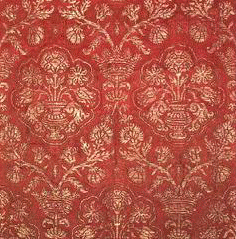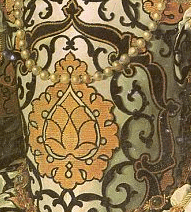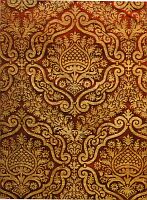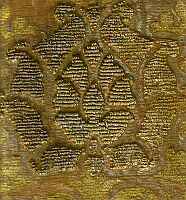by La Signora Katerina da Brescia.
The Florentine economy was run by both the Medici mercantile
empire and its clothing industry (producing both dress textiles and
linens). Florence was a major textile producer in the 14th and 15th
centuries, including wools (from Spanish and English wool), silks. These
included damask, satins, tabby embellisehd with raised loops of
different heights in gold and silver, which were amongst the most
expensive fabrics. Some fabrics - such as
doublesided (with one colour on each side) with raised loops -
were a technical masterpiece that is difficult to reproduce, even
today!
Fabrics were ranked from matallic gold and silver, pattened,
brocaded, boucle effects with differing heights of loops, velvets,
satins, damasks, rafera and ermisini. Next were woollen cloths, linen
and felts. The most expensive fabrics were usually used for furnishings, royal
gifts and trouseaus.
A well known example of expensive material is the famous Bronzino painting of Eleanora with her son Giovanni - white, gold, black (expensive colours) with differing levels of boucle effects (technically hard and expensive).
Veil making started in Florence in 1476, being particularly popular in the second half ofthe 16thC.
Extant Gowns: (UPDATED MARCH, 2007.)
|
There are not many extant examples of clothing from Florence in the
16th C, and most are from the second half (1560s and after). I do have a wonderful
picture of Eleanor de Toledo's reconstructed burial gown in white satin, from
goldsword.com - made from white silk satin. This is also
discussed in Janet Arnold's Patterns of Fashion and La Moda a Firenze. La Mode also discusses another extant dress from Pisa (often assumed to belong to Eleanora d'Toledo). This is of red velvet (Right). L'Abito della Granduchessa; Vesti di corte
di Madonne nel Palazzo Reale di Pisa
shows us glimpses of two other extant Florentine sottana. One is made
of green velvet, the other of linen/wool. This is an incomplete sottana
and is undecorated.
Otherwise I
have no other extant examples of complete dresses, from this specific
area and time. Researching
Florence 1500- 1550, narrows the field making research
more difficult to find. There are some extant samples of material
(either not made up or used for chausables or furnishings) at various
museums
(listed below). These are usually generally labelled '16th C'. Not all
of them can be identified to a specific area of Italy.
|
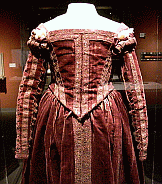 |
Patterned Materials in 16th C Italy:
In general, designs were symmetrical and mirrored running
vertically along the material , floral patterns appear to be a common
motif.
A History of Textile Art
discusses silk/velvet
pomegranite designs 15thC & 16thC. The pomegranite pattern
deveoped in the 15thC and was popular into the 16thC. The acorn, trunks
and pears were also used. Checks were used commonly for guazes (
La Moda a Firenze, p190)
Material Patterns in Portraits:
Portraits often show plain materials of single colour as well as how
patterned materials have been used in Florence. There are also
extant examples (not made up unfortunately) and documentation of multi-coloured patterned Florentine materials.
|
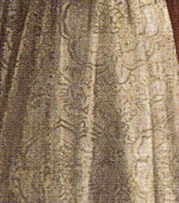
|

|
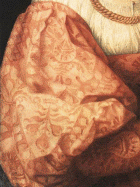
|
|
PRE 1500: Domenico Ghirlandaio's Resurection of the Notary's
Son 1479-1485 (overdress)
|
Rafffaello's Portrait of Maddalena Doni,1506
(sleeves)
|
Jacopo Portormo's Lady with a Basket of Spindles,
1516 (sleeves and dress)
|
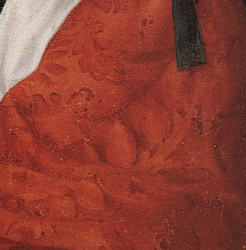 Bacchiacca's Lady with a Nosegay, 1520's (sleeve)
Bacchiacca's Lady with a Nosegay, 1520's (sleeve)
|
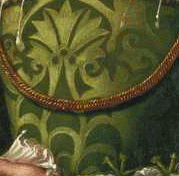 Florentine Noblewoman by Unknown Artist. (1540) (sleeves and dress)
Florentine Noblewoman by Unknown Artist. (1540) (sleeves and dress) |
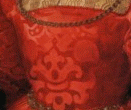
Bronzino 1545-46 (sleeves and dress same colour) |
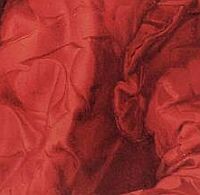 Portrait of Lucrezia Panciatic
hi bronzino 1550
Portrait of Lucrezia Panciatic
hi bronzino 1550
(zimarra - loose gown) |
|
|
Material Widths:
The usual width of material was 58cm, but looms wider than this are not
uncommon for plain fabrics. (satin, taffeta, maybe damask) La Moda a Firenze p 184.
Loom widths are recorded from 73cm to 117 cm (2 braccia). Wider loom widths made materials more difficult to work, especially for piled fabric.
Examples of differing loom widths are:
- Gold damasks, gold and sivler tabbies (doublesided) (curtains and bedspreads) - also woven on looms 73 cm (1/4
braccia).
- Satin (Eleanora's burial) - 1 1/;4 braccia wide.
-
velvets with 2 braccia widths have survived.
-
140cm wide loom (1499) velvet was worked in florence.
Extant Examples of Material Pattens from Florence:
(Thanks to Mistress Oonagh for supplying me with some of the following
examples of Florentine extant materials.)
Possibly the most well known material pattern,of this time, is Eleanora;s dress in the Bronzino portrait of her and her son.
And from earlier centuries - to give an idea of how patterns have
developed...
|
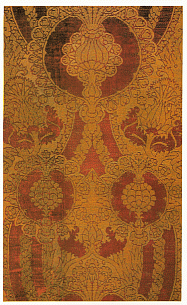
|
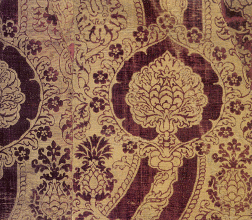
|
|
|
Above L:Cleveland Museum of Art -Silk Velvet with
pomegranate pattern, possibly Florence, 15th century
|
Masters of Florence Exhibition - 15thC cut
velvet |
|
Colours used in Florence
Types of Materials:
The Art of Textiles lists common types of materials in Italy,
in the first half of the 16thC, as cut velvet, ciselé, pile on
pile velvet, brocatelle, damasks, lampass with brocade trams, gold or
silver bouclé. Cisele velvet has two types of pile, cut and uncut giving differing
shades of the same colour became the preferred choice for imported
garments in the second half of the 16thC.
- BROCATELLE - is a double jacquard fabric with satin or twill
pattern on a plain or satin background. It is a double weave with
silk and lines warp with a silk and linen filling - giving an
embossed pattern with a 'blistered', raised relief pattern
- BROCADE - is made from a weave of jacquard and dobby. (A type
of loom on which small, geometric figures can be woven in as a
regular pattern.) The pattern can be in satin weave with a twill
background or the other way around - twill pattern on a satin
background. There is occasionally with metallic or coloured
threads to make a design, making the design stand out with the
figures being loose.
- BOUCLE- can be of any weavewhich is looped giving a rough
appearance. .
- CISELE VELVET - a velvet with the pattern made in cut and
uncut loops with a higer profile than uncut velvet.
- DAMASK - has a shiny pattern on opaque background, all in one
colour and reversable. It was originally made of silk and can be
made of linen.
- LAMPAS - a type of jacquard material with the raised pattern
bound in tabby or twill. It can be 'two tone' or in many colours.
- PILE ON PILE VELVET - A velvet with a design created using
different levels of pile
- SATIN - originally made of silk, with a glossy front surface
and a dull back. It is produced by a twill weave with the
weft-threads almost hidden.
- TWILL - material which is woven to give a surface of diagonal
parallel ridges.
- VELVET - material made from a pile weave wtih an extra warp
yarn. It can be made of silk, cotton.
Today many of these weaves can be found in natural and man-made
fibres. The trick is to try to find a close approximation of the
weaves and patterns in the cheaper fibres - often in the furniture
sections of haberdashery stores.
The Materials favoured by Eleanora d'Toledo: (1538-1562)
The following is recorded in her Gardaroba; (La Moda a Firenze, p88, 100, 112)
Eleanora loved the play of textures - velvet/satin, wool/velvet, wool/satin.
Petticaoats: (90)
satin silk
damask silk
velvet silk
wool, saia and rascia
precious (satrins patterned gold, gold or silver tabby, llops raised, gold and silver guaze, striped black veiling.) |
24
21
18
15
40 |
Gowns (40)
velvet
satin
gauze - gold, silver
(gowns worn over petticoat in winter, for warmth) |
11
10
3
|
Zimarra /loose gowns
satin
velvet
light er misino (tafetta)
wool
gold, silver cloth, guaze and net
striped black veiling (1559) |
31
20
17
11
6
1 |
Cotton in Italy:
From the 12th and 13th century, Florence imported
cotton from Levant (the best quality) to be made into textiles.
Cotton was also imported from Calabria (p 31) and Acre (p
36) in the 15th century but were of lesser quality.From the 15th
century, cotton was also sourced cotton from
Gallipoli -p 44, Constantinople - p 48, Greece p 48, Syria - p 37 and
Egypt - p48. (
Italian Cotton Industry in the Later Middle Ages 1100-1600). This was used to make materials either entirely of cotton (
satellari, p167) or mixed with linen (
fustian - p 90), silk or wool (
Italian Cotton Industry in the Later Middle Ages 1100-1600, Introduction)
to create a greater range of textiles. These were most likely more commonly used by the middle class and lower class.
Cotton was used by the
upperclasses for clothing items such as veils, hoods, handkerchiefs,
gloves, purses, fringes, ribbons, linings in hats and garments,
padding, quilting and for embroidery (
Italian Cotton Industry in the Later Middle Ages 1100-1600
p 100). It was also used for other household itmes. Milan and Florence
were rivals, in the cotton textile industry, during the 15th century.
During the first half of the 16th century, the cotton industry was
declining, due to cheaper manufacturers and in the increase of the
industry in North Germany and Flanders, economic strains, various
wars with the Turks (in the latter 16th century), making access
to Levant cotton less certain.
Italian Cotton Industry in the Later Middle Ages 1100-1600 p 53)
Cotton materials tended to be relatively plain. Onamental cottons, such
as tapesties, brocades and embroided materials, were not found in
Italian cotton textile production. Printed cotton was not known in
Medieval Europe. (
Italian Cotton Industry in the Later Middle Ages 1100-1600, p 90).
BIBLIOGRAPHY:
- Agnes Geijer ,A history of textile art, London. Pasold
Research Fund in association with Sotheby Parke Bernet. Totowa,
N.J. : distributed by Biblio Distribution Center, 1979 (This was
from the ANU library.- with scans from Mistress Oonagh)
- Kovesi Killerby, Catherine, Sumptuary Law in Italy
1200-1500, Oxford University Press. NY. 2002.
ISBN:0-19-924793-5
- Piponnier, Francoise & Mane, Perrine Dress in the
Middle Ages, Yale University Press, New Haven, 1997. ISBN:
0-300-08691-1
- Crowfoot E, Pritchard F & Staniland K, Textiles and
Clothing 1150-1450, Boydell Press, Woodridge, 2001 (ed) ISBN:
0-85115-840-4
- Arnold, Janet Queen Elizabeth's Wardrobe Unlock'd, Maney,
Leeds, 1988, ISBN:0-901286-20-6
- Arnold, Janet Patterns of Fahsion, MacMillan, London, 1985.
ISBN: 0-333-38284-6
- Fennell Mazzaoui, Maureen. Italian Cotton Industry in the Later Middle Ages 1100-1600, Cambridge University Press. Cambridge, 1981. ISBN: 0521 230950
- Frick, Carole Collier. Dressing Renaissance Florence.:
Families Fortunes & Clothing. John Hopkins University Press.
Baltimore. 2002. ISBN: 0-8018-6939-0
- Jones, Ann Rosalind & Stallybrass, Peter. Renaissance
Clothing and the Materials of Memory. Cambridge University Press.
2003. ISBN: 0-521-78663-0
- Bruker, Gene A. Renaissance Florence. University of
California Press. Berkely. 1983 (reprint). ISBN:m0-520-04695-1
- L'Abito della Granduchessa; Vesti di corte
di Madonne nel Palazzo Reale di Pisa. Museo Nazionale di Palazzo Reale,
Pisa.
- Orsi Landini, Roberta & Niccoli, Bruna. La Moda a Fioenze 1540-1580.
Pagliai Polistampa, Firenze, 2005. ISBN: 88-8304-867-9
- The Art of Textiles by Alberto Tagliabue
http://www.thais.it/arti_minori/tessuto/italiano/Italiano2.htm
- The Art of Textiles - definitions:
http://www.thais.it/arti_minori/tessuto/glossario_uk.htm
- The State Hermitage Museum Digital COllection
http://www.hermitage.ru or http://www.hermitagemuseum.org - search
Textiles Italy(?)
- LACMA Collections online:
http://collectionsonline.lacma.org/mwebcgi/mweb.exe?request=record&key=13756
- All About Fabrics - Dictionary.
http://allaboutfabrics.com
- Oonagh's Own: hhttp://www.geocities.com/oonaghsown/
- Medici Archive Project: www.medici.org/ (1/06)
© K Carlisle , Sept, 2006

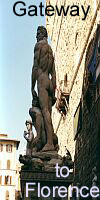





 Bacchiacca's Lady with a Nosegay, 1520's (sleeve)
Bacchiacca's Lady with a Nosegay, 1520's (sleeve)



